Mike Vardy's Blog, page 66
December 15, 2016
3 Steps to Building Productivity Habits That Stick

“Sow an act and you reap a habit. Sow a habit and you reap a character. Sow a character and you reap a destiny.” – Charles Reade
Productivity requires taking action on your intentions. The best way to make progress with your intentions is to find a way to pay attention to them. Productivity habits – repeated actions that pair your intentions with attention – are an excellent way to do this.
But this kind of progress doesn’t happen overnight. You need to build productivity habits that become part of your character. No matter what time of year it is, you can work towards building productivity habits – and building ones that will stay with you for both the short and long term.
Ready to start building your habits today? Here are 3 steps to building productivity habits that stick.
1. Simplify as much as possible.
“Truth is ever to be found in simplicity, and not in the multiplicity and confusion of things.” – Sir Isaac Newton
When you want to build productivity habits that stick, you need to make them as simple as possible. This allows you to stack habits one on top of each other to craft routines in your days and weeks (and beyond). This allows you to go into a form of “autopilot” so that you can let your mind tackle the things that fall outside of routine in a much more effective way.
Simplification can come in the form of taking on less stuff whenever possible. It can come in the form of reducing the number of tools in your toolkit. There are always ways to simplify – to take something back to its simplest form – so that you can redesign it, rebuild it the way you want it to take shape, and reclaim your time, focus, and energy.
I encourage you to look at one thing you’re doing right now that seems overwhelming but would have a huge impact on you if put into practice. See how much you can simplify the one item so that the benefits are largely untouched but the overwhelm you’re feeling is minimized.
I bet you’ll find that you can simplify more things in your life. And remember – simplicity scales.
2. Create Productivity Pillars.
A pillar is defined as “a firm upright support for a superstructure.” Your life is most certainly a superstructure. That’s why you need to create “Productivity Pillars” to act as supports for your life.
There are several types of Productivity Pillars that you can put in place. One is to use Daily Themes to give yourself an overarching focus for your day. This will allow you to come back to focused work faster after being distracted or disrupted. You’re not asking an open-ended question like “What should I do now?” Instead, you’re asking a question with only one possible answer: “What day is it today?” This allows you to resume your daily tasks without veering too far off course.
Another Productivity Pillar to have is a consistent way to capture your ideas and tasks. Again, you want to simplify this as much as possible. Being able to look at any sheet of paper and know immediately what you’ve done, what you’re not going to do at all, and what you haven’t done is incredibly powerful. Why? Because it lowers the chances of falling prey to paralysis by analysis and allows you to move forward intentionally and attentively faster.
My Productivity Pillars are all part of The NOW Year™ Method that I created and teach to others. They include My Three Words, My Monthly Themes, My Daily Themes, and one that I use to make the third step in this process take shape.
3. Give yourself 2-3 ways to tackle your to do list.
Look at your to do list right now. Go ahead…the words will still be here when you get back.
Can you easily decide which way you want to tackle your to do list? How much time do you spend examining your list instead of executing the tasks on it?
I can look at my to do list – whether it is written on paper or entered into an app – and decide in less than a minute which way I’m going to approach it. How? Because I’ve given myself 2-3 ways to work through it. I can work one of the following 3 ways:
Project: This is the way most people work because we’ve been conditioned to do so. There’s nothing wrong with working this way. But it isn’t always the ideal way. Projects can stall. Then momentum is lost in the process. I work by project as a second or third resort. I do this by choice rather than by force because of the other two ways I can work. (I indicate a project name for most tasks so that I can easily see what project they belong to. Then I group them all together and get working.)
Schedule: I actually work this way infrequently because I’ve got a personal productivity framework in place that allows me to be proactive far more often than reactive. Still, I do indicate when certain things on my to do list need to be done before a certain time period so I can take care of them well in advance. (I mark tasks that require scheduling on my to do list with either an AM or PM depending on when I need/want to work on them. You could get more specific than that, but I don’t need to.)
Mode: Every action requires a mode in order for it to be worked on. That’s why this is the most common way I work. Modes can be categorized by theme (like Daily Themes), resource needed (person, product), energy required (low, high), activity to do (anything ending in “ing”), and/or time (simplified so there are as few options as possible – like 5min, 15min, 30min). Working by mode is the best way to get into a state of flow and is the closest anyone can get to multitasking. This works because you can move multiple projects forward by working in one mode. (I sometimes have multiple modes attached to a task, which gives me options on when to work on a task based on my Daily Theme, energy required, and time needed to do it.)
Even when I find myself stumbling or veering off course on my productivity – which happens – the productivity habits I’ve built allow me to get back up. I can continue to move things forward in a way that works best for me quickly and easily. I trust these habits because they’re firmly engrained in my mind.
These productivity habits I’ve built have done something else for me, too. They’ve built my character and continue to help me grow.
To help you out with this process I’ve created a free course in partnership with Todoist and Skillshare called Building Productivity Habits that Stick. In the course I dive into the basics of creating a simple, flexible, durable productivity framework will transform the way you work. Whether you’re a freelancer balancing multiple gigs or a 9-5er with a calendar full of meetings, this class will give you the tools you need to maximize your time at work and at home. You’ll learn to:
Foster awareness to make strategic decisions
Establish smart habits that support your needs
Use tools effectively to simplify your workflow
The class has received tremendous review so far:
“Productivity, goals, and task management is an ongoing challenge. I find myself constantly chasing after the latest tools and apps that promise to bring sanity to the chaos of helping get my to dos in order. But, as Mike Vardy points out in this course, productivity apps and tools are only as good as our framework for managing our days. He provides actionable steps to take control of our day and move towards accomplishing what matters to us.” – Ryan R.
“Wow. I’ve never taken in so much in such a short period of time. Normally, you’d have to read 200 pages of a book or hours of video to get practical tips in this class. I’ve already adapted my learning into my daily workflow.” – Mike B.
“I like the more open-ended approach to productivity. I’m not someone who has had success with scheduling and sticking with productivity plans. This one is so simple and gives so much freedom that I might actually be able to stick with it for the long haul!” – Calhoun G.
After taking this class, you’ll have an arsenal of strategies to personalize your productivity and to ensure you’re getting the right things done.
I hope to see you in class. Enroll here today.
The post 3 Steps to Building Productivity Habits That Stick appeared first on Productivityist.
December 13, 2016
The Jolt
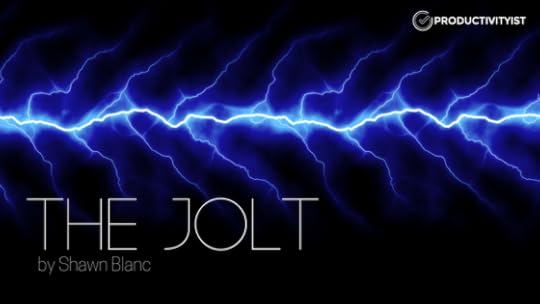
The following is a guest post by Shawn Blanc, creator of The Focus Course and host of the Creative Focus Online Summit . Shawn is a writer, small-business owner, productivity coach, and creative entrepreneur living in Kansas City with his wife and their three sons.
My life changed forever when my wife and I had our first child.
Becoming a dad was one of the most incredible and defining moments of my entire life. In fact, I’d say fatherhood is perhaps the most prominent milestone marker of my life.
But there’s more to the story.
Before our first son, Noah, was born I decided to quit my job and work from home and write for a living.
It was Christmastime in 2010. My wife and I were having dinner after returning from Colorado. We had just gone through a deeply challenging loss in our family. As a result, Anna and I started talking about having kids.
The combination of a personal tragedy and the excitement of starting a family brought my whole life into slow motion. Things that were once important suddenly seemed meaningless to me. Things that were once side passions now seemed immensely important. So many of my “priorities” were completely uprooted.
I knew it was time to quit my job of 10 years and try my hand at something new.
Sometimes You Need a Jolt to Help You Make a Choice
It sounds so “bold” — to quit my job on the cusp of starting a family — but it was one of the easiest decisions I’ve ever made. And once I made the choice to quit my job and to start writing my website as my new full-time gig, everything else fell into place.
Do not underestimate the power of decisiveness and action.
Decisiveness brings motivation for action. Action brings clarity. And clarity helps us make future decisions.
I love to geek out over things. I will spend hours and hours researching something to death because that sort of work is fun to me.
But sometimes my need to hyper-research and test something can be dangerous.
When I want to make a change in my life, or when I want to invest in something that I know will be a critical part of my everyday life, I can obsess over it. Spending far too much time researching, thinking, and talking with people about it.
It can literally take me months or years to make a decision (if ever).
My love for learning about (and sweating) the details is one of my greatest strengths. But it can also be a weakness.
Something you’ll hear Mike and I discuss in the Awareness Building Class is how I leave a note out for myself at the end of each work day.
I do this because if I didn’t, then I might never get any writing done. There are times when I need to be told what to do — times when I am paralyzed by decision. But then, once I’ve begun moving, then the action brings with it so much clarity.
Action brings clarity.
Here’s a short story I’d like to share with you.
A little over a year ago, I finally began running. I’d been putting it off for years because I wanted to do “the best” workout routine possible. What would have the maximum impact in the shortest time with the least effort?
Ugh.
One day I realized that if I didn’t just start doing something — anything — then I may never start.
So I did the easiest thing I could do:
I bought a Couch to 5K running app that literally told me what to do. All I had to do was listen and follow the instructions.
I went to a store where they analyze your gait and help you get the right running shoes. I walked around and answered questions while someone picked out the right shoes for me.
And then, I came home and started running.
Starting simple and allowing someone else to tell me what to do removed a huge barrier for me. And now, over a year later, I’m actually running instead of still just thinking about running.
Sometimes it takes a tragedy or other type of wake-up call to give us the push we need to get moving. Other times, we need to shut up and let someone else tell us what to do so we can just get started already.
In part, that’s exactly what The Focus Course is. It’s like “Couch to 5K” but for your whole life.
Do you need a Couch to 5K app in order to start running? Not really.
Likewise, could you go out on your own to get clarity on the principles and action items found within the Focus Course? Most likely. In fact, I have nothing to hide here: I’ve listed out all of the books, articles, podcasts, white papers, and other resources I used as part of my research to create The Focus Course.
What makes The Focus Course so valuable is how approachable it is.
The course starts out simple, easy, and fun. And over 40 days the course builds on itself so that by the end you’ve seen significant progress and change and have actually done something.
Peter Drucker says that “the greatest wisdom not applied to action and behavior is meaningless data.”
Knowledge alone is not enough to create lasting change. Which is why The Focus Course is about more than just head knowledge — it’s an introduction to experiential knowledge.
Without any hyperbole, I mean it when I say that The Focus Course can change your life.
However, Mike and I are not just here to try and convince you of the power of The Focus Course.
It is also an example to encourage you that not every decision or project should be researched to death.
If there is something you’re putting off because you think you need to research it more, consider if it’d be better to just start now with the easiest point of activation. And then, let your experiential knowledge bring clarity about what to do next.
Something I have learned — that is still a struggle for me, honestly — is that sometimes
I just need to start. Oftentimes what I call “research” or “prudence” is actually just procrastination.
Procrastination left unchecked will gain momentum. The longer you put something off the easier it becomes to keep putting off.
The post The Jolt appeared first on Productivityist.
December 12, 2016
The Productivityist Podcast: Broadcasting Happiness with Michelle Gielan
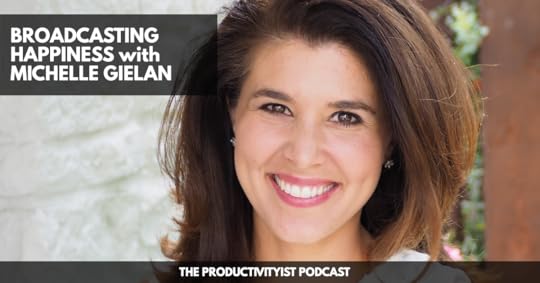
We’re “broadcasting happiness” on this episode of The Productivityist Podcast with my guest Michelle Gielan, the bestselling author of Broadcasting Happiness.
Michelle was a national CBS news anchor turned happiness researcher, founder of the Institute for Applied Positive Research and has a new special airing on PBS called Inspire Happiness with her husband, fellow happiness researcher Shawn Achor. On this episode she talks with me about how our attitudes affect our lives and productivity, and learn about:
What the idea was and what happened for “Happy Week” when she was still working as an anchor in CBS (03:40).
Her insights on the influence of the news on the brain based on research she conducted with Shawn Achor and Ariana Huffington (06:06).
Transforming your relationship to email, our brains’ negativity bias, and how emailing positivity can change your day – and even make you see the world differently (09:00).
The problem with Happy Monday emails (12:27).
How important it is to focus on behaviour instead of the person and what are the predictors of long-term success (16:30).
What things you can do to promote change with people you’re interacting with daily (19:51).
The importance of words to help people get on a positive track and an experiment that shows how words affect people’s behaviour (25:23).
How to create a more positive relationship with your to-do list by “recrafting” it to fuel your brain (28:48).
Relevant Links
michellegielan.com | Michelle Gielan
Broadcasting Happiness | Website
PBS Special | Inspire Happiness
Broadcasting Happiness | Amazon
Shawn Achor | Good Think Inc
The Happy Secret to Better Work | TED talk with Shawn Achor
Wake Up & Inspire Happiness Video Workshop | Website
Michelle Gielan | Twitter
Michelle Gielan | Facebook
If you enjoy The Productivityist Podcast I’d appreciate a rating and review in iTunes or your podcasting platform of choice. It helps people find the show easier and will help me make improvements on the show by seeing what you have to say.
Want to help the show even more? Then become a patron of The Productivityist Podcast through our Patreon campaign! Check out The Productivityist Podcast’s Patreon page and take a look at all of the perks – available only to Patreon supporters!
The post The Productivityist Podcast: Broadcasting Happiness with Michelle Gielan appeared first on Productivityist.
December 8, 2016
The Fight
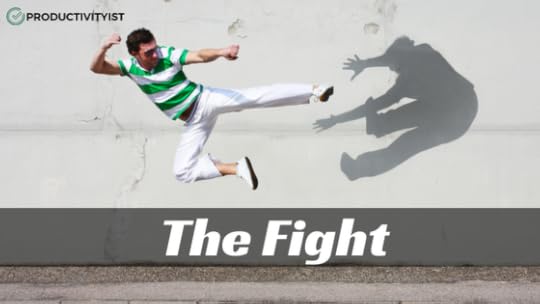
The following is a guest post by Shawn Blanc, creator of The Focus Course and the host of the Creative Focus Online Summit . Shawn is a writer, small-business owner, productivity coach, and creative entrepreneur. For more than a decade, Shawn has been teaching and learning about creativity, diligence, and focus.
Every now and then an idea hits you like a ton of bricks.
You’re reading something, or listening to something, or driving to work and a couple of dots connect in your head. Kapow!
As I’m writing this, I have one particular idea in mind that I want to share. Something that connected for me several years ago and has had a profound effect on me ever since.
It’s the idea of living like nobody else.
This metric of living differently goes far beyond just how you spend your money. It’s also an excellent metric for how to spend your time, energy, and attention.
My friend Aaron Mahnke says to do as much as you can with as little as you can for as long as you can.
Lifestyle creep and workflow creep put a ceiling on our potential. They rob us of our much-needed resources which include time, money, and energy.
This is the idea I wanted to share with you today: living like nobody else. To do this, you must FIGHT what is considered normal.
Did you know…?
The average American spends 5 hours or more watching television and 2 hours on social media every day.
The average retiree at age 65 has only enough in savings to pay for less than 2 years worth of living expenses.
One of the most common regrets of the dying is that they worked too hard and neglected their relationships, values, and even their own happiness.
And who knows how many men and women have a dream to start a business, write a novel, paint a painting, or build something meaningful, but never try.
Unless we win the lottery, it’s a logical impossibility that we can waste our money and also end up wealthy. The same is true for our time and attention.
Unfortunately, most of us aren’t surrounded by focused and successful individuals who can set an example for us. No one reminds us to keep on keeping on. We have few examples of intentional and considered living. However, we probably have plenty of examples of how to watch TV, check Facebook, and live outside of our financial means.
What if you lived like nobody else?
Don’t spend hours each day watching television or scrolling through social networks.
Don’t let your work life dominate over family time, personal values, or happiness.
Don’t ignore the importance of investing in the long-run and planning for the future.
Live as far below your means as is reasonable, and don’t derive your happiness or self-worth by the fanciness of the things you own.
Don’t let laziness or busywork keep you from building something meaningful.
Don’t assume you need a better tool in order to do better work.
It’s funny. Simply doing the opposite of what most people do can actually open up many opportunities for you to do meaningful work.
Change is hard. We fear it.
We get overwhelmed by all the areas we want to change. We get paralyzed by the options for how we could change. Or we’ve been there and done that, and since it didn’t work out that one time we’ve thrown in the towel for good.
But here’s the truth: You can change.
I realize that this all sounds so serious. Like we’re still little kids who don’t know how to behave. Hey, you! Watch less TV. Turn off Facebook. Do your homework.
Yes. It is serious. But that’s because it matters. It’s also awesome and fun. Getting ahold of your life is liberating (to say the least).
Of course, the choice is yours to make.
Ask yourself if you would prefer to be up-to-date on all the latest TV shows or if you want to create something every day?
Do you want to stay in the loop with the lives of your Facebook friends, or do you want to help your kids build a fort and do their homework?
Do you want to squeeze in one more thing at the office, or do you want to go on a date with your spouse?
Now, I realize all these options aren’t continually at odds with one another — they’re not mutually exclusive. And it’s not that TV, Facebook, and late nights at the office are always “bad” all of the time.
Life is a messy, zig-and-zag balancing act.
I’m being dramatic to make a point. Because I know that in my own life, and in the lives of my close friends and family, if we aren’t careful and intentional, then over time the natural trajectory of life begins to move downward.
Focus, diligence, relationships, wealth, art — anything at all that is worth pursuing — is a moving target.
A note from Mike: Shawn and I have put together a free live training event called Meaningful Productivity that we’re presenting on Wednesday December 14th at 2 pm ET/11 am PT. We’re going to dive into the building of personal productivity workflows, time management strategies and tools we use, and offer a live Q&A segment as part of the event. We’ll also be offering a replay and the ability to submit questions prior to the event.
Don’t miss out! Click here to register for this free event.
The post The Fight appeared first on Productivityist.
December 6, 2016
How to Be in Two Places at Once
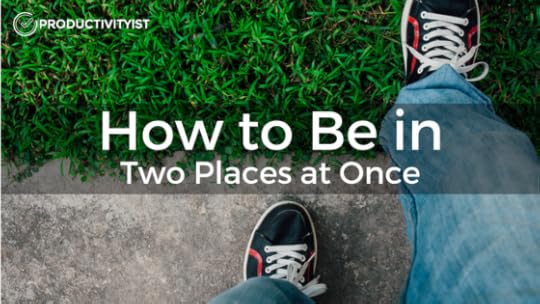
The first movie my wife and I ever watched from the comfort of a living room couch was A Walk to Remember. (I still “might” tear up when watching it.)
There’s a scene in the film where Landon (the boy) fulfills Jamie’s (the girl) wish about being in two places at once when they straddle a state line. I thought it was cute – and I actually did it myself when I straddled the line from British Columbia to Alaska a couple of years ago. (Yes, I was in two countries at the same time…technically speaking.)
A more impressive example was the invention of a machine that actually was able to be in two places at once thanks to quantum physics.
“This breakthrough was achieved by physicists Andrew Cleland and John Martinis from the University of California at Santa Barbara. They created a machine consisting of a tiny metal paddle made of semiconductor material that was just visible to the naked eye. By supercooling the device, they made it vibrate by getting thicker and thinner at a frequency of some 6 billion times a second, producing a detectable electric current. They even managed to get it to vibrate in two energy states at once, both a lot and a little – a phenomenon allowed only by the rules of quantum mechanics.” (The Independent, December 2010)
However you don’t need to be a quantum physicist or have to straddle borders to be in two places at once. You can do that from anywhere you are and at anytime.
The easiest way to do this is to chronicle your thoughts and then refer to them at the end of the day when you recap your day. Whether you journal in a digital or analog journal, you’re still operating in two different places: the past and the present.
Another way to be in two places at once is to map out your day ahead of time. This places you in both the present and the future. If you’ve been keeping up with your past experiences along the way, then you will be more realistic when planning future events.
All that stated, it is still best to spend your time in one place at one time.
“The past is behind, learn from it. The future is ahead, prepare for it. The present is here, live it.” ― Thomas S. Monson
Instead of wishing you could be in two places at once, strive to double your focus in the one place you are…the present. After all, it’s the place that matters most.
Speaking of being in two places at once, today is the day my session went live at the Creative Focus Online Summit. In this session Shawn and I discussed boundaries, clarity, and more. If you haven’t yet registered, you can still sign up for free and get access to my session as well as all of the others.
Today also marks the first day of the Productivity Success Summit, which brings together 30+ world leading entrepreneurs, small business owners, authors, influencers and productivity experts. My session presents the concepts of time theming and mode-based work. I’ll examine both topics in greater detail. (Here’s a sneak peek of me talking about why time theming works.)
You can get your free ticket for the Productivity Success Summit here. Don’t hold off. The ticket is free for now but when the event is over access to the speaker sessions will be $497!
The post How to Be in Two Places at Once appeared first on Productivityist.
December 5, 2016
The Productivityist Podcast: Fostering Creative Focus with Shawn Blanc
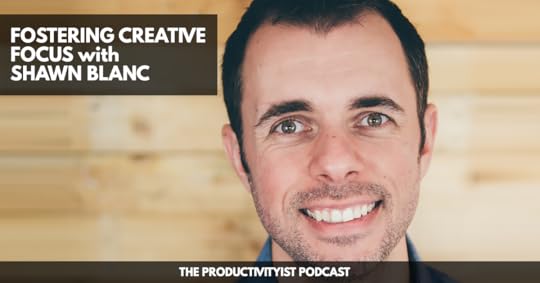
Shawn Blanc is back on The Productivityist Podcast and on this episode we dive into the subject of creative focus. A father of three, Shawn has a passion for creative focus and productivity, regularly writing about these topics on his blog since 2007.
In this episode, Shawn and I talk about his upcoming summit, the systems and tools he’s employed in both work and life, his core values, and books that he’s bought but might not have necessarily read.
Some other specific subjects we tackled in this episode are:
The Systems vs Tools Debate and how Shawn uses both to traverse his life (02:07).
How his work values and practices relate to his family life (03:55).
The concept of personal integrity and the future self, plus a simple exercise he does on The Focus Course to establish these concepts (06:07).
The Blanc Media Core Values (09:53), the guidance given to him by Barrett Brooks to articulate these values, and how it ties up with his business direction (11:10).
The concept of traction and how to apply this in real life…and towards reaching your goal (17:52).
An article he wrote titled Learning Not to Think About It, what it meant for him, and how he does it (22:38).
His reading practices, how he expounded on this in his article I Buy More Books Than I Read (26:48), and one book that has really impacted him in making choices, changes, and spending his time for the coming year (31:35).
Finally, he talks about the Creative Focus Online Summit, The Focus Course and how these can help us to manage our time and other areas of our lives (35:34).
Relevant Links
shawnblanc.net | Shawn Blanc
Blanc Media Core Values | Shawn Blanc
Barrett Brooks | Website
The Power of a Focused Life | The Focus Course
How to Get Time For Your Projects | Shawn Blanc
Learning Not to Think About It | Shawn Blanc
2 Experts Share Exactly How to Use a Productivity Journal (& Increase Productivity by 23%) | The Fizzle Show
I Buy More Books Than I Read | Shawn Blanc
Goodreads | 2016 Reading Challenge
The 10X Rule: The Only Difference Between Success and Failure by Grant Cardone | Amazon
The Creative Focus Online Summit
Shawn Blanc (@shawnblanc) | Twitter
If you enjoy The Productivityist Podcast I’d appreciate a rating and review in iTunes or your podcasting platform of choice. It helps people find the show easier and will help me make improvements on the show by seeing what you have to say.
Want to help the show even more? Then become a patron of The Productivityist Podcast through our Patreon campaign! Check out The Productivityist Podcast’s Patreon page and take a look at all of the perks – available only to Patreon supporters!
The post The Productivityist Podcast: Fostering Creative Focus with Shawn Blanc appeared first on Productivityist.
November 28, 2016
The Productivityist Podcast: Beyond the E-Myth with Michael E. Gerber
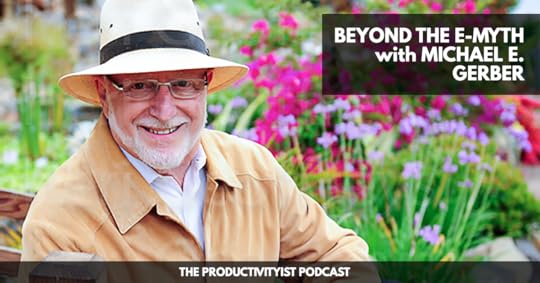
Michael E. Gerber, founder of Michael E. Gerber Companies and author of The E-Myth Book Series is my featured guest this week. He discusses the main concepts of his new book, Beyond the E-Myth.
Michael is a pillar of business development and coaching going as far back as the 1970s, and his insights on systems, startups and scaling up businesses into enterprises will be central in this episode. You’ll hear about decades worth of business acumen and you’ll learn about:
What is a company of one, and how to build and scale it up (02:05)?
How he started his business, his experience creating the first business development / coaching firm, and how he positioned it (03:39).
The E-Myth series and its promise to fix broken businesses (which is a difficult thing to do), and how did that play a part on his decision to create Beyond the E-Myth (8:17).
The concept of Old Co and New Co, the difference and transition between the two (7:53, 10:03)
The mindset that Michael wants entrepreneurs to have when conceptualizing their businesses (12:20).
The definition and the four components of an entrepreneur (16:40), and the concept of The Dreaming Room™ to awaken the entrepreneur out of anyone (21:42).
How to employ a business development program that even novices can operate (20:39).
Relevant Links:
Michael Gerber Companies
Beyond the E-Myth
Michael E. Gerber on Amazon
Michael Gerber on Twitter, and Facebook
If you enjoy The Productivityist Podcast I’d appreciate a rating and review in iTunes or your podcasting platform of choice. It helps people find the show easier and will help me make improvements on the show by seeing what you have to say.
Want to help the show even more? Then become a patron of The Productivityist Podcast through our Patreon campaign! Check out The Productivityist Podcast’s Patreon page and take a look at all of the perks – available only to Patreon supporters!
The post The Productivityist Podcast: Beyond the E-Myth with Michael E. Gerber appeared first on Productivityist.
November 24, 2016
Review: Zen And The Art Of Work
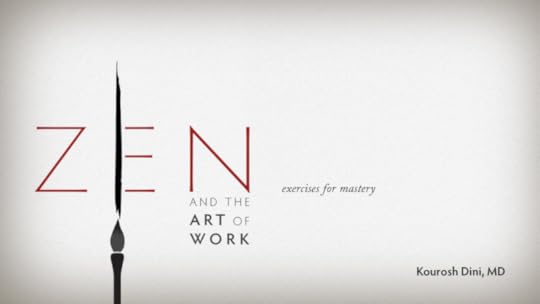
There are several authors out there whose name I find synonymous with quality. There is an assumed level of trust and expectation when I pick up their work. There is also a calming knowledge that, when finished, I will feel enriched. One such author is Kourosh Dini.
When I reviewed the second version of Creating Flow with OmniFocus by Kourosh Dini here at Productivityist and I was blown away by the attention to detail and structure of the prose. The way he was able to take a complex application like OmniFocus and simplify it was truly impressive.
When I heard that Kourosh was releasing a video series called Zen and The Art Of Work, I couldn’t get access to the product quickly enough. Could he convey his messages as well via video as through the written word?
The answer is a resounding yes.
Zen and The Art Of Work is a 16 part video course specifically targeted at those who are feeling overwhelmed. I have to confess, when I first saw the titles of the modules, I was apprehensive. I was afraid I wouldn’t learn anything new. Setting Thoughts Aside, Creating Next Actions, Reviewing Systems were just examples of content that I assumed I was fully conversant with.
I was so wrong. I learnt something new in every single module. Even the Introduction. Some particular highlights include:
Pausing before every session, so as to make a settled decision on the work to be completed.
Clearing the Inbox after every session of work.
Just showing up for work. Even for a short period of time, just be there.
When I started the introduction video, the first thing that jumped out at me was the clear intention to provide an experience for the viewer. Kourosh is a skilled pianist, and the audio piping through my speakers was an absolute delight. I immediately reached for my headphones so that I could shut myself off from everything around me. This is definitely how I recommend consuming this course. The combination of the music, alongside the narrator’s calm, soothing voice is akin to meditation. It’s almost impossible not to focus.
As well as the audio, a video course needs to look the part as well. One look at the canvas patterns shows that the author understands this too. It would be so easy to just produce words on a blank background, yet Kourosh hired a designer with the sole purpose of creating visuals that will put the viewer at rest. This helps reduce friction between the foreground and background. And it works. There are great fonts, images and designs all round.
There is no assumption based on the user prior to sitting through the course. No task management application required, no online productivity tools – nothing. There’s just the understanding that the videos will be completed in sequence. Each builds on the last and there is a unique exercise to be completed at the end of each module.
By the end of the course, you will be able to:
Build trusted systems
Relieve overwhelm
Form habits
Maintain high levels of attention
As well as much more.
I cannot recommend this video series enough. There is content here for everyone, no matter what your level of prior exposure to productivity techniques and at $34.95, it’s great value.
If you click here you also receive a copy of the Soundtrack: Zen and the Piano which is worth the price of admission alone.
The post Review: Zen And The Art Of Work appeared first on Productivityist.
November 21, 2016
The Productivityist Podcast: James Sudakow
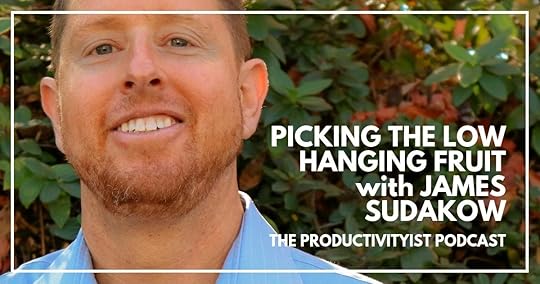
James Sudakow, author of the book Picking the Low Hanging Fruit, is this episode’s guest and we talk about the language people use in the corporate world.
Every organization or group got acronyms, buzzwords, or phrases that is used on a daily basis. On this episode, James and I discuss how these can benefit organizations – but sometimes cause disconnect in communication. James also reveals some buzzwords that he thinks people should stop using by the end of the year, and how an individual can shift away from the habit of using such words.
Let’s “open the kimono” on this episode and learn about:
People’s intentions when they choose to use big words (8:20).
How to stop this practice in organizations firmly entrenched into such kind of language (13:25).
James’ list of buzzwords that people should retire from use by the end of 2016 (2:16), and the most obscure phrases he’s heard (29:28).
An open letter James wrote on his blog tackling the ridiculous lingo being used in the corporate world (15:39).
The probability of grandiose language masking larger organizational problems (17:19).
How acronyms initially intended for efficiency can quickly spiral out of control (20:28).
One small thing an individual can do that can result in a shift from the practice of using these kind of words and phrases (22:54).
Relevant Links:
Home | James Sudakow
Picking the Low Hanging Fruit: And Other Stupid Stuff We Say in the Corporate World: James Sudakow, Todd Kale: | Amazon
“Re-invented” is the new corporate buzzword that gives me a headache | James Sudakow
A new approach to ridding us of stupid corporate lingo | James Sudakow
CH Consulting | James Sudakow
Why do corporate types love acronyms so much?
James Sudakow’s articles | Inc.com
James Sudakow (@JamesSudakow) | Twitter
If you enjoy The Productivityist Podcast I’d appreciate a rating and review in iTunes or your podcasting platform of choice. It helps people find the show easier and will help me make improvements on the show by seeing what you have to say.
Want to help the show even more? Then become a patron of The Productivityist Podcast through our Patreon campaign! Check out The Productivityist Podcast’s Patreon page and take a look at all of the perks – available only to Patreon supporters!
The post The Productivityist Podcast: James Sudakow appeared first on Productivityist.
November 17, 2016
Hack Your Road Trip with These 6 Productivity Tips
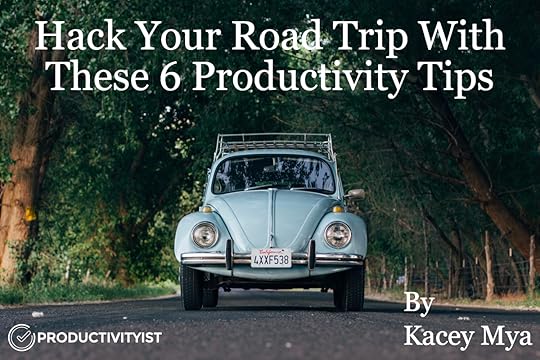
Today’s guest post is by Kacey Mya. Kacey is a lifestyle blogger for “The Drifter Collective.” She finds excitement in the world around her and this is portrayed through her visually pleasing, culturally embracing and inspiring posts. You can connect with Kacey on Twitter, Pinterest or Instagram.
When you prepare for a road trip, a little foresight before and during the trip can result in a great time devoid of stress. A road trip has the potential to refresh and expand your mind, as well as serve as a truly memorable experience. But it’s more realistic if productivity is kept in mind throughout the entire process.
Here are six productivity-minded tips to hack your road trip and make for an efficient, relaxing and clutter-free trip:
1. Take Time to Research and Use Travel Apps
As romanticized as the prospect of hitting the open road without any plans or directions at all is in movies, it’s not a great idea. Especially in the year 2016, when we have a variety of travel apps to give us directions and help us find attractions. There’s no excuse not to have some foresight and use a few travel apps to help with research.
Knowing where you’re going ahead of time will make it easier to be productive and focus on things that matter, like ensuring that everything is packed and the car is being driven safely.
2. Document Your Packing List on Phone Instead of Paper
Since paper is easier to misplace, it’s more practical to document your packing list on a phone, tablet, or laptop. Email the list to yourself and text it to others, so if your phone or device gets damaged or lost you will still have the list. On the other hand, if you used paper and it got misplaced or lost, there’s no way to recover it.
Your packing list for the trip should be amended before, during and after packing. Start with the list of things you want to pack. Once you figure that out, check the items during the actual packing to make sure they’re all there. Then confirm everything is packed. Also, knowing where it is can save time in the long-run, which boosts the productivity for everyone traveling.
3. Don’t Pack the Night Before or Morning Of
It’s a bad idea to leave packing until the last 24 hours. It’s better to gradually pack over the week. Start with items you generally won’t need for the week prior to departure but still need for the trip. Some examples are non-perishable foods, water, tissues or first aid kit.
One common foresight is forgetting change needed for tolls. A week or so before your trip, calculate your estimated route and toll charges via Google Maps or another map platform. For instance, if you’re traveling in New Jersey or Pennsylvania – the states with the two most profitable toll roads – the frequency and cost of tolls throughout your route would be good to know. This will save you time instead of to being forced to calculate the amount of change needed several times on your journey.
4. Avoid Over-Packing
Reduced stress and minimal clutter will result in a more enjoyable road trip. Pack your suitcases minimally and efficiently. Choose proper luggage and consider using travel gear, like a mini brush or travel-sized toothbrush. When packing, place everything outside your suitcase first, so you can verify that it’s all there without having to dig through everything at the end. Avoiding over-packing so you can make more room for interesting purchases throughout the trip. This will also give you less stress, as there will be less things to worry about losing or cleaning.
5. Become Comfortable with the Surroundings
To ensure the best road trip possible, you should map out your route and become familiar with the roads and landscape. Google Maps provides street views that can help you familiarize yourself with what to expect, particularly whether a particular route is a busy highway or country road. Knowing what to expect can alleviate the stress out of driving a long distance. This will also help clear your mind so you can focus more on the act of driving itself and anything else that needs your attention.
6. Don’t Stop Every Chance You Get
For any road trip, it’s important to make the stops count. Strive to enjoy and savor moments instead of being tied to a strict to-do list or clock. Realize that stopping unscheduled somewhere will take away time from a future destination. It’s important to weigh the consequences of an unexpected lengthy stop. It’s important to be capricious to some extent when on a road trip, but to maintain a productive and stress-free trip it’s vital to be picky in choosing where to stop.
With these six tips, it’s entirely possible to maintain productivity throughout a road trip and, as a result, experience a stress-free and very enjoyable adventure that you’ll always remember with fondness.
The post Hack Your Road Trip with These 6 Productivity Tips appeared first on Productivityist.



